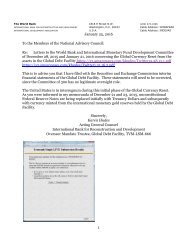KILLING-US-SOFTLY1
KILLING-US-SOFTLY1
KILLING-US-SOFTLY1
You also want an ePaper? Increase the reach of your titles
YUMPU automatically turns print PDFs into web optimized ePapers that Google loves.
IV.<br />
COMPARATIVE ANALYSIS – METHOD TO MADNESS – THE LESSER EVIL<br />
FOR THE GREATER GOOD<br />
Taking on man’s primal instincts is a difficult task. The instinct to breed is second only to the<br />
instinct to live and the Global Depopulation Policy has challenged both. Not surprisingly, the<br />
results are mixed.<br />
1. CHINA’S One-Child Policy<br />
111% population growth since 1960; TFR 1.6 (-73%); 400 million births prevented<br />
Since its introduction in 1978, the One-Child Policy has prevented the birth of 400 million<br />
Chinese. Without it, China, which has a population of 1.35 billion, would have had a population<br />
of 1.75 billion, thus 30% more.<br />
Prior to its introduction in 1978, Chairman<br />
Mao encouraged large families and opposed<br />
family planning programs. During the 30 years<br />
that Mao Zedong was in office (1945-1976),<br />
China grew from 540 to 940 million people<br />
and thus nearly doubled its population. Had<br />
the government done nothing and the same<br />
growth levels would have continued, China<br />
would now have nearly 2 billion people and<br />
none of the prosperity that has made it the second most powerful economy in the world.<br />
Market-based economic reforms coupled with population controls have catapulted China to<br />
unprecedented prosperity. Its gross domestic product (GDP) took off as soon as the One-Child<br />
Policy was implemented and in the ensuing three decades it grew 18-fold. China now has a per<br />
capita income of $6,091.<br />
There is no question that in purely economic terms the One-Child Policy, coupled with freemarket<br />
reform, has been a phenomenal success. But what are the social and political drawbacks<br />
of the policy<br />
To better understand the following data readers will need a brief lesson in demographics, the<br />
study of populations. A country’s population is the result of two primary factors, namely how<br />
many people are born in any given year and how many die, thus the balance between fertility and<br />
mortality. The population explosion started when our improved medicine and quality of life<br />
enabled nearly all children to survive birth and the first critical years of life, while at the same<br />
time extended people’s lives into old age.<br />
To stop the population explosion governments began adopting family control measure to lower<br />
fertility and set as their target an average of two children for every woman, which is known as<br />
28











